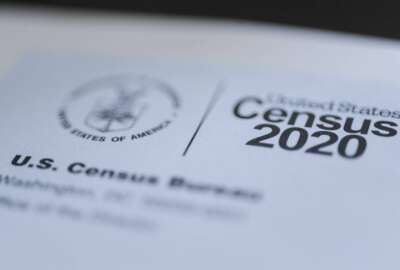Details on how the census actually causes distribution of federal funds
How often have you heard it said: The census count determines how much federal money a state, county or city will get. Data analysis by the Project on Government...
How often have you heard it said: The census count determines how much federal money a state, county or city will get. Data analysis by the Project on Government Oversight (POGO) shows that supposition is not quite as simple as it sounds. For more, Federal Drive with Tom Temin spoke with POGO senior policy analyst Sean Moulton.
Interview Transcript:
Tom Temin So what were you looking at here? You went back and kind of countered the methodology that the census uses in its statements about how the money gets distributed based on the decennial count. What were you looking at here?
Sean Moulton Well, we wanted to look at was a slightly narrower definition that the Census Bureau did put out some updated data just earlier this year talking about the use of census data, which was very helpful. But they took a very broad look, which is fair. It’s their agency and they get to take credit for any time someone uses their data. I won’t begrudge them that. But what we were really concerned about was when local census numbers, state, city, county numbers, when they are what get depended upon for money that then reaches that state, county, city. And so that geographic allocation, the Census Bureau included programs in there like Pell Grants, educational Pell Grants, where census data is used to set sort of a national eligibility, a household income eligibility. But if you get your numbers wrong in Maryland, it’s not going to affect Maryland students’ applications to Pell Grants. And so everyone’s going to be kind of affected the same. So it doesn’t geographically change the distribution of money in Pell Grants. What we looked at were programs where if you got an undercount or even an over count, it might affect how much money your region got. So again, we looked at a slightly narrower definition.
Tom Temin And what are some of those programs that do vary by the actual number of noses they managed to come up with?
Sean Moulton It’s a lot of programs that people have probably heard of, not that people have heard of all the federal programs out there. You have to be pretty wonky like me to know those names. But I mean, Medicare, Medicaid, those are some of the big drivers of these numbers. SNAP, which used to be called food stamps for people, remember them that way. But the Supplemental Nutrition Assistance Program, Head start school lunch, school breakfast, highway construction. It makes sense even when you hear that, that they’re being driven by the population they’re trying to serve. It really was I think it was 338 programs, federal programs that we identified. Yeah. I mean, it accounted for $2.1 trillion in a single year of spending. We looked at fiscal year 2020 because we wanted to make sure all the money had been fully spent. And $2.1 trillion more than that in one year.
Tom Temin Well, did you find any anomalies? That is to say, no one knows really, whether the count was right or not. The count gets certified and that’s the count. And there’s no real other source of information other than conjecture to say, well, no, our county has 50,000 more people you missed.
Sean Moulton Yes, you’re right. The decennial census that happens every ten years, that is definitive. We really don’t change that. But what the Census Bureau does is after each decennial census, they do a post count survey. And when they did that, they basically take a statistical sample in every state and they send out a follow up survey and they see if there are differences, immediate differences, people they missed at households or people that got over counted. And their survey this year revealed statistically inaccurate counts in a number of states. We had undercounts in I think five states, over counts in seven states, and that was statewide. What they didn’t get into was undercounts and over counts, messed up counts in local areas in your city, in your county. So we could have even more, you know, in Detroit or in Atlanta, we might have undercounts that aren’t big enough to skew the whole state, but they’re big enough to skew how much money is going to that particular city.
Tom Temin We’re speaking with Sean Moulton. He’s senior policy analyst at the Project on Government Oversight. And I guess there’s another question that maybe wasn’t part of your study, but I’m looking at just one of the 34 pages of those 300 and some programs that you list. And let’s say, you know, National School Lunch Program that’s been around forever, $24 billion program. It’s a lot of lunches, a lot of macaroni. But is there a correlation simply by the head count or is it the student count because you could get the same amount of money, one county to the next, but the other one has 50% more school aged children locally? How fine grained does it get?
Sean Moulton It gets very fine grained. Each one of these programs, people often try and simplify it and say, Well, my state got X amount of money and there’s this many people in my state. So per person we got say, you know, $10,000. So every person we missed, we lose $10,000. It is not that simple. It is far from that simple. As you’re saying, there’s a good number of these educational programs, school lunch, school breakfasts, Title one. What they really care about is school children. So if you miss an adult or an elderly person, it doesn’t matter at all. It’s not going to affect those programs and Title one grants to schools, those are even more specific. It’s not just schoolchildren, but it’s schoolchildren from households below the poverty level you’re talking about within school children age. You know, what about the kids from the poor areas or poor neighborhoods? Are you missing those? And again, every program is a little different. And so it gets to be not just how many people that you undercount, but exactly who did you miss or over count, I should say. Sometimes over counts can cost you money as well.
Tom Temin Now, how does that work in something like highway planning and construction from the Transportation Department? 40, almost a $46 billion program. Does it go by how many miles of roads you have in your area? Because that’s not something the census counts or how many bridges and this kind of thing.
Sean Moulton No, no. The highway program is more about the number of people that a state has. That money goes to states to a state agency. And so it comes down to how then the state agency distributes it within their area and whether or not they use census. This is the federal distribution. And sometimes the federal distribution comes directly to your city. Community development block grants go straight to counties and cities and bypass state agencies entirely. But something like the highway they use census data, I should say to allocate the money. But then it goes to a state agency who has a lot of control over then where that money gets spent that year.
Tom Temin Sure. But just to look at it from another angle, take a little tiny state like Rhode Island geographically, but it’s got many more people than a gigantic geographic state like Wyoming. Wyoming might have more miles of roads than Rhode Island. I don’t know that to be a fact, because there’s more density in cities and so forth around, you know, Pawtucket and there’s cities that have lots of streets density, not so much in Wyoming for the most part, but it’s nevertheless a calculus based on population.
Sean Moulton Well, it’s a calculus based on in part on population. The census part is the population, but they do take into account that program other factors, such as you’re saying, miles of road, but that you’re right, that doesn’t come from a census. So the census part is going to be a straight population number.
Tom Temin Got it. So when Congress then or when the Transportation Department decides where their $46 billion in roads go, they don’t rely only on the census data, in other words.
Sean Moulton Correct. Some of these are complete formulas with lots of other factors being brought in, census being one of them. Others are thresholds, money going to rural areas. Whenever you see something about like rural electrification, how we distinguish if an area is rural or urban, that’s entirely based on population density. And so that’s a good example where an over count could wind up missing out an area on money. Because if you’re getting a high enough population that you’re close to that threshold between counting as rural or county as urban, if you over count your population a bit, you might cross that threshold and no longer qualify for any of the rural money that’s out there.
Tom Temin Got it. Well, then, based on all of this analysis, what’s your sense that the census should do anything different? Are they doing everything pretty much the way they should constitutionally? And according to, you know, what seems fair for distribution of federal funds?
Sean Moulton I think census is doing a lot right. There’s big changes afoot. Last decennial census, the first time we used administrative records really to fill in some of this stuff, which makes sense. There’s a lot more data available in sort of government records already. What I think we need to do is we need to properly resource and support these efforts. We need Congress to be properly funding the census. They begrudged the census. It’s an expensive operation to count so many people. But the reality is a lot of money depends on it. This is pennies on the dollar. I mean, we depend on these decennial numbers for ten years, trillions of dollars every year that we’re spending. And if we get them wrong, we’re sending the money to the wrong places. The other big thing I think that I take away from this is that states need to get more involved. As I said, we had a number of states with undercounts, over counts, and those states need to play a bigger role in encouraging their citizens to participate, making sure they understand how to fill out the census, not to fill it out if they’re moving at a particular date or if they have more than one. Residents fill it out once and to fill it out accurately.
Copyright © 2024 Federal News Network. All rights reserved. This website is not intended for users located within the European Economic Area.
Tom Temin is host of the Federal Drive and has been providing insight on federal technology and management issues for more than 30 years.
Follow @tteminWFED





